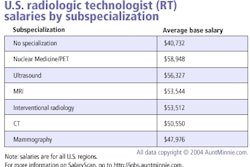

On one hand, digital images are making virtual reading and interpretation possible, freeing radiology physicians to practice anywhere. On the other, the growth of interventional procedures is requiring more direct patient care. The result is proliferation of procedures performed and an increasing complexity to physician activities and schedules.
Over the past 20 years, radiology practice management has evolved from the relatively simple task of separate billing to complex business management of a very competitive environment.
Successful practice management means adhering to changing Health Insurance Portability and Accountability Act (HIPAA) and Medicare regulations, as well as delivering successful return on investment for outpatient imaging center locations and modalities. It also means increasing the use of certified coders to provide the highest level of performance and feedback to physicians.
Finally, practice managers must contend with dramatic radiology physician shortages, while still delivering a high level of healthcare professional business expertise to support growth and prosperity. It is rapidly becoming impossible for a physician in-house operation to hire, retain, and afford the needed level of expertise to capture high revenue, ensure compliance, and enable growth. The answer to this dilemma may lie in practice management outsourcing.
The conundrum: in-house or outsource?
Consistent, successful delivery and collections for radiology services requires participation and interaction among multiple administrative organizations and healthcare providers. In addition, these parties must access multiple information systems with many applications, all of which must be correlated with multiple contractual agreements.
There are surprisingly few practice management organizations -- ranging from in-house billing operations to the largest billing companies -- that take advantage of available computer-to-computer and network-to-network integration capabilities. The majority of coding, billing, and collections operations are still derived from paper, including patient demographic face sheets, superbills, and dictated reports.
In the early 1990s, it was assumed that physician billing would be fully electronic by the year 2000, almost like a credit-card transaction. Instead, with few exceptions, the billing process continues to be driven by paper, particularly with in-house operations.
Because the complexity of procedures and compliance issues continues to increase, there is little hope this scenario will change anytime soon. Worse yet, there is little capital or operating margin available for many billing companies -- particularly those that have grown by acquisition -- to dig their way out of these highly fractured manual processes.
Continually evolving HIPAA and Medicare regulations add to the increasing challenges of correctly coding complex procedures in a manual paper environment; something has to give. Hiring more staff is usually the path chosen and, other than increasing costs, it rarely provides relief.
Making the decision to outsource, with the intent to connect with the right level of expertise and technology, can be even more daunting. The problem is that a great many outsource companies are in no better shape than in-house billing operations. Too many of them are operating on shoestring margins, having acquired customers in price wars, or with the expectation of automation, find themselves operating at a loss and lacking the resources or time to significantly improve their position.
The outsource solution
The success of healthcare organizations depends on the creation and maintenance of the right partnership or outsourcing relationships. Establishing the right partnership requires the ability to assess whether the potential partner or outsourcing company provides the services and skills needed to complement the company's own core strengths. It also requires an understanding of what services and skills are required to help a physician group grow.
The partnership must deliver complementary business value, and produce a relationship that will grow returns beyond the initial consultation. In the case of practice management, and billing in particular, several elements are essential for successful outsourcing.
Automate information transfer
In the 1980s, a common belief was that the entire healthcare billing and collection process would be an automated electronic process within 10 years. In the 1990s, the belief still held that the laborious paper-based process of coding reports, collating face sheets, and submitting claims to payors would most certainly become no more complicated than an ATM transaction, eliminating high costs, time, and lost revenue. Yet another decade later, the same manual paper-based billing processes are still firmly in place in the majority of billing operations, particularly in-house billing.
An electronic interface with the hospital or imaging center system to obtain patient demographic information is a step in the right direction. Another important step is obtaining the transcribed reports electronically, although the benefit is only derived from a system that can electronically match reports with the patient demographic information.
For most physician group in-house operations, it is infeasible to develop and maintain electronic interfaces, much less be able to develop a download engine that can automatically match information. But just having an electronic interface is insufficient.
Electronic interfaces must be accompanied by several key elements:
- Solid information technology support from the billing company
- Good relationships with the hospital IT departments and imaging center staff
- Interface and downloading engines to match demographic and report information
Finally, electronic interfaces must be able to respond to frequent changes that occur with information systems, or run the risk of incorrect billing and lost charges.
Put the effort up front
As the saying goes, it takes 10 times more effort to fix a problem than to prevent it. This applies to managing a practice, particularly billing. If a claim is sent out with the wrong insurance information, it takes somewhere between 60 days and forever to get paid. A high percentage of uncollectible receivables may be properly attributed to poor patient demographic and insurance information up front.
Initial demographic information for patients admitted to a hospital is too often incomplete. This can be remedied by ensuring that the hospital admitting department or business office has had a chance to update the demographic information before claims are submitted.
If information is received via electronic interface, which is preferable, work with each hospital to determine the number of days after the admission date that the hospital will need to update patient demographic information -- before the interface file is created and sent to the billing company. Work with the hospital admitting department to ensure it is obtaining treatment authorization requests (TARs) and that the information is also transmitted to the billing company.
In the case of outpatient imaging centers, spend the time to regularly train the registration staff on the importance of getting authorizations, TARs, advance beneficiary notifications (ABNs), and correct insurance information. While it can be difficult to ask patients for personal information, registration staff must understand the importance of determining how the patient will pay for services. There should be virtually no bad debt in an outpatient imaging center, where the group has control of the quality of information obtained from patients.
Deliver efficient and accurate coding
Health plans and government programs, such as Medicare and Medicaid, have fee schedules and rules for services. Medical services lacking proper documentation, diagnosis, and indications for diagnostic procedures are disallowed and not paid by insurance companies and government programs.
Understanding the rules of the road can mean the difference between working for free and getting paid for a legitimate, allowed procedure. With the reimbursement for many interventional or MRI procedures in the hundreds to thousands of dollars, that difference can be painful.
In addition to the financial aspect of proper documentation and coding, there is the issue of compliance with Medicare and HIPAA regulations. As always, ignorance is no excuse. Proper documentation of radiology reports is a must. Appropriate coding is done from the dictated report, which must stand alone as evidence that the procedure was performed.
Like many things in life, successful execution comes from solid training and education. A good practice management company can train physicians on the most effective and compliant methodology that will result in the proper reimbursement for its hard work.
Coding has become a complex discipline, particularly with interventional procedures. While many companies providing outsourced billing have good coders, very few employ certified coders. Certification requires concentrated, continuing training and education to stay abreast of changes and nuances. When selecting an outsourcing company for practice management, consider inquiring about the certification level of its coders.
Capture every charge
Billing for physician services and getting properly paid is a challenging business. What is most surprising, however, are the number of procedures that never get billed. Some estimates for the percentage of lost charges industrywide run as high as 8% to 10%, with specific instances as high as 20%.
Few in-house or outsourced billing companies have adequate mechanisms to ensure that all performed procedures are billed. If billing is paper-based and manual, there is little chance of effective audit procedures to ensure capture of all charges. Electronic capture of procedures and reports provides the opportunity to audit against the RIS logs, but again, few companies do so.
When selecting an outsourced practice management company, make sure a process is in place to capture 100% of all procedures performed every month. An occasional or even a routine sample audit is insufficient.
In rare cases, practice management companies have automated the entire process in which the patient demographic interface feed, the dictated reports, and the RIS log are correlated so that every procedure is captured. When the RIS log shows that a procedure was performed and there is no dictated report, a process is in place to request the outstanding reports. The same process is applied to missing demographic reports.
This process of maximization of data recovery could easily translate into 10% of additional revenue for the group physicians, which will certainly be well-appreciated.
Ensure compliance
The U.S. Department of Health and Human Services Office of Inspector General (OIG) has stated that it will be looking at physician groups to ensure compliance with HIPAA and Medicare regulations (HHS/OIG Fiscal Year 2004 Work Plan, U.S. Centers for Medicare and Medicaid Services).
Additionally, the increasing complexity of interventional and other diagnostic radiology procedures, coupled with ever-changing Medicare rules, is making compliance a more difficult issue for physician groups.
Physician groups and other healthcare organizations need a compliance program specific to their organization, and one that outlines how they are going to meet all federal regulatory requirements. The program should stipulate who is on the compliance committee, who is the compliance officer, and how the healthcare services delivered remain in compliance, including an approach to continuing education.
Ensuring continuous compliance is becoming more complex and more difficult. Having someone on staff who is able to juggle other responsibilities and stay tuned into compliance issues while remaining current with changing regulations is all but impossible. Utilizing a professional for this important role enables a physician group to tap into a high level of expertise, skills, and current knowledge.
Maintain professional, focused expertise
Professional, successful people are often attracted to companies that provide a career path in the area of their specialization. In the case of practice management and compliance, such career opportunities are going to reside in companies that provide services to multiple clients. For a physician practice, support functions for the group are billing, collections, and compliance. From a career standpoint, these functions are a beginning and end in themselves. Therefore it is not only difficult to recruit and retain talented, professional people to provide these services within a medical practice, it is also prohibitively expensive.
The partnership model, via outsourcing, provides the best opportunity for delivery of such expertise. Each organization contributes its core strengths and expertise to achieve high performance and success. The physician group focuses on delivering high-quality radiology imaging services, while the practice management company focuses on the business of converting imaging services into cash at the lowest cost/highest revenue and in full compliance.
Deliver business success
There is nothing more successful than success. All the technology, techniques, and processes are meaningless if success is not delivered. Despite best efforts, all practice management companies will suffer the occasional mistake, miscalculation, omission, or staffing issue. Successful companies are those that recover from such problems and overcome obstacles.
If you are looking to outsource some or all of your practice management services, look for a company that delivers:
- High collection rates
- Accurate coding by certified coders
- Professional compliance services
- 100% reconciliation on charges each and every month
- Assistance that helps your group succeed in the marketplace
In short, look for a company that delivers success -- yours.
Routinely audit and improve performance
Like it or not, nothing ever continues as begun. Regardless of how well processes and technology are designed and implemented, they always seem to lose focus over time. This is particularly true with practice management, a business that requires 100 things be done right every day.
Success occurs because processes and technology are routinely audited, and refinements continuously implemented. Errors become opportunities to improve old processes and implement more modern technology. Process improvement never ends.
Radiology physician groups have been separately billing for professional services for more than 20 years -- a relatively short time. The evolution of this practice has been governed largely by circumstance and inertia.
Having started small, the practice has evolved as a substantial and necessary operational expense. On the outsource side, the early small billing companies have grown largely by consolidation, resulting in larger companies that are nonintegrated operations, usually in several locations using multiple applications and platforms.
The choices for practice management, until very recently, have been limited to in-house billing and the rare good billing company. Physician practices have largely operated in two ways: with the hope of hanging on to qualified personnel and staying somewhat in compliance, or by outsourcing to a billing company that may or may not have provided professional results.
Radiology physician groups are under increasing pressure to maximize revenue to support the high demand. Compliance with HIPAA, Medicare, and other agencies is becoming very complex and distracting when physician groups need to be looking at market opportunities, such as imaging center development and additional reading contracts.
Companies that specialize in radiology and offer comprehensive practice management services are beginning to evolve. The need to carefully select a practice management company that can enable the group's success is a higher priority now than any time in the past 20 years.
By Kerry Kearns
AuntMinnie.com contributing writer
October 28, 2004
Kearns is director of business development for Long Beach, CA-based Radiology Practice Management, a physician management service company. For more information about the firm, phone 562-590-7400 or visit its Web site at www.r-p-m.com.
Related Reading
Compliance program provides protection, metrics, August 2, 2004
Radiology group pays $2.5 million to settle alleged Medicare fraud, June 29, 2004
Automated claim coding pays off in time and money, May 11, 2004
Diligent coding means money in the bank for breast imaging, May 21, 2004
Billing mistakes cost Medicare $11.6 billion, U.S. says, November 17, 2003
Copyright © 2004 Radiology Practice Management



















